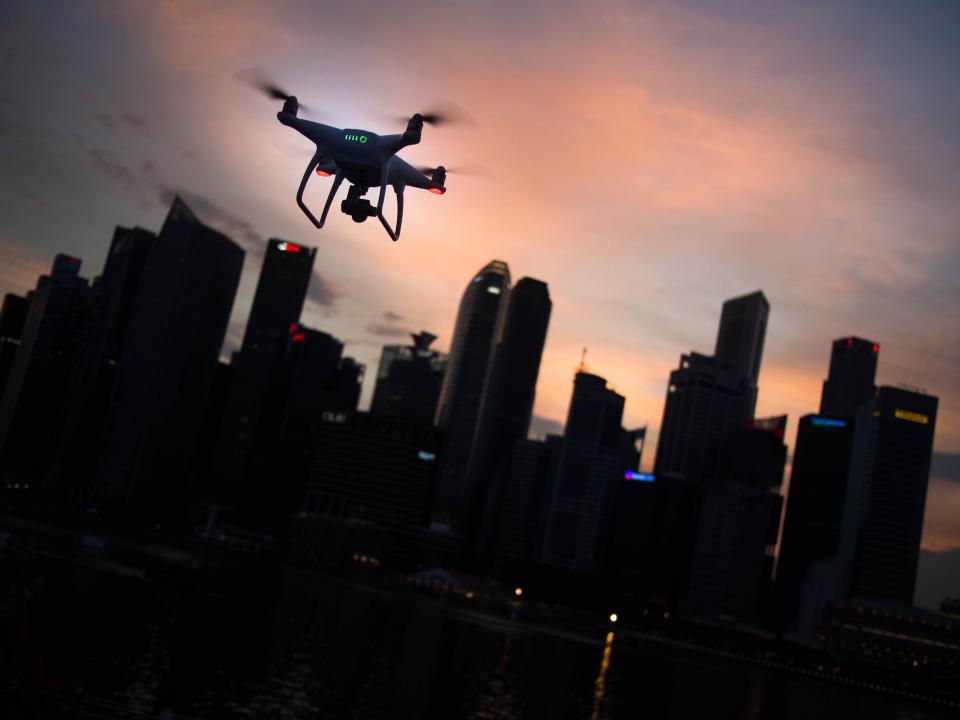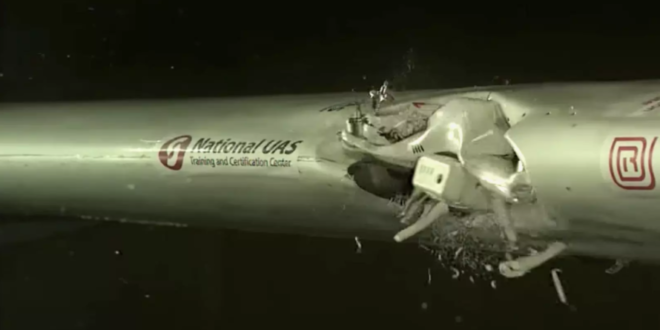You’ll have struggled to miss the explosive video and research publicized by the University of Dayton earlier this month. Unsurprisingly, the footage made headlines around the world, further justifying the usual media hysteria that rises any time a drone pilot flies too close to an airplane.
At the time, DroneLife editor Miriam McNabb pointed out that the research represented an unlikely scenario as a realistic one, that geofencing and other protections keep commercial drones away from aircraft, and that alternative research exists that suggests the result of a collision may not be as dramatic as Dayton would have you believe.
As you might expect, DJI also followed up on the study, which used a Phantom 2 as its drone of choice. The company had some strong words to say and demanded that the video be removed. In a letter to UDRI’s Kevin Poormon, Brendan Schulman systematically outlined why the testing was flawed. He also posed the question as to why the research institute was more concerned with generating publicity than results that would actually be useful to the world of aviation.
Since that letter, UDRI have added a single paragraph to their initial release, stating, “The test was intended to compare a bird strike and a drone strike, using a drone similar in weight to many hobby drones and a wing selected to represent a leading edge structure of a commercial transport aircraft. The drone and gel bird were the same weight and were launched at rates designed to reflect the relative combined speed of a fully intact drone travelling toward a commercial transport aircraft moving at a high approach speed.”
Make of that what you will. They have not addressed any of the claims made by DJI specifically.
So what are we left with? Well, a damaging video has made the rounds. Anyone who has seen it will be left with the impression that drones present a clear and inherent danger to manned aircraft – particularly as it was published without sufficient context to help people understand the feasibility and likelihood of such a collision.
The truth is that we still don’t exactly know how dangerous drones are during a collision with a manned aircraft. There are so many factors at play that thorough studies are hard to come by.
The closest we have so far is from ASSURE, a body consisting of 23 of the world’s top research institutions and more than 100 leading industry and government partners.
The FAA and ASSURE released the results of their Air-to-Air collision study last year, providing some key points to help the industry better understand the physical damage associated with drones colliding midair with commercial and business aircraft. But that work is very much still ongoing.
With all of that in mind, we wanted to know if the drone industry’s manufacturers could do more to support scientific research in the field. As well as critiquing contrived studies, are they doing all they can to understand the potential risks drones pose to airplanes? In short, are they putting their resources where their mouths are?
We spoke to DJI’s Adam Lisberg and new public policy manager David Hansell, as well as Stephen Luxion, Executive Director at the ASSURE FAA Center of Excellence for UAS, to find out more.
The Bigger Picture: Comprehensive Testing is a Huge Undertaking
In the past, I’ve noted that as long as near misses and dubious research continue to be publicized, breaking the cycle of conjecture, fear and negativity is going to be difficult. Unless, I’ve suggested – as have many others – manufacturers and other industry stakeholders come together to fund a joint study into the dangers of drone-airplane collisions.
In practice, that kind of arrangement would arm the industry against negative publicity with science and even provide manufacturers with the information they need to alter designs and build safer aircraft.
However, testing on that kind of scale would require a huge amount of resources. It’s one thing to lend drones to an academic institution for testing. It’s quite another to design your own experiments, rent out your own laboratory and smash your drones around for a few months. Unfortunately, with the inevitable millions of dollars needed would come a great amount of arguing over who should pay for it.
They’d never get anything done.
Which is why it probably makes sense to be patient while ASSURE continues with its ongoing tests, coordinating the efforts among academics while relying on the advice and expertise of industry stakeholders.
Stephen Luxion, Executive Director of the ASSURE FAA Center of Excellence for UAS, explained as much.
“Congress established ASSURE as a Center of Excellence for UAS because of the complexities of safely, effectively, and efficiently integrating this new emergent technology into the National Airspace System. ASSURE is an alliance of 23 leading research universities that take this task very seriously and work very hard as a team with our industry partners and the FAA to meet this mission,” he said.
“No single entity can meet this challenge on its own. It is the combined the efforts of ASSURE and other FAA research entities, industry, and the government to work through the many new challenges that unmanned aircraft systems bring in maintaining safety of the national airspace while unleashing this new industry and all it will do to serve us and make our lives better.”
DJI, the only manufacturer we reached out to for this piece to provide any insight at all, is one of those partners.
“The depth and quality of the research we do could not be done without the support of industry partners and drone manufacturers like DJI,” said Luxion. “They bring their knowledge, expertise, equipment, and concepts of operations to ASSURE research projects. We conduct 3rd Party Research that informs the FAA and US Policy.”

DJI: We will continue to support legitimate testing labs
Speaking to DroneLife, DJI’s corporate communication director Adam Lisberg expanded on the company’s original letter to Dayton.
“Does this hurt the business of drones? Yes, probably,” he said. “But more importantly, it hurts the interests of the people who benefit from drones. From people who want to safely fly for the fun of flying, all the way up to people who use drones for complicated business undertakings.
“When you create a perception that drones are dangerous, you hurt all of those people’s interests,” he said.
“That’s why we work with legitimate testing labs like ASSURE. They put out straightforward reports. And their reports don’t say ‘drones are perfectly safe’. They say ‘here are concerns and issues for the industry and regulators to look at’”.
Ultimately that’s what the industry is looking for: valuable information garnered in a rigorous manner. “They put out all their data so that people can understand their testing procedures and what they’ve learned. They do that and we’re happy to give them drones to crash, and have our technical experts spend hours with them – because the results are done in the interests of science to try and make everything better, not just to try to get a headline,” said Lisberg.
He also explained that DJI has provided similar materials and expertise to the aviation regulatory body in China for testing purposes.
We got in touch with a few other manufacturers and industry stakeholders. Yuneec was the only other company to respond:
Sensational videos are a long way from qualifying as study or serving a purpose beyond generating views. Ill-conceived collision studies can have a negative impact on the drone industry if they influence regulation and mislead public perception on the safety of drones.” – Yuneec Spokesperson.
Read more: DJI Refines Geofencing and Ditches AirMap for PrecisionHawk
DJI’s Approach to Aviation Safety
DJI’s public policy manager, David Hansell, gave us a little more insight into why industry and regulators need to work together on drone collision testing. Chief among the reasons is that this is all so new to the world of aviation, so there’s little wonder that controversial studies are being released.
“We are equally challenged with this being – within the lifespan of aviation – a relatively new technology,” said Hansell. “The testing protocols which do exist, which we eluded to in our response to Dayton’s PR effort, don’t even envision drone and aircraft collision testing yet.”
The best you can do to be in the spirit of the regulations is to try and get close to weight and speed as contemplated in the FARs. That’s a challenge for regulators: to come up with testing that makes sense. We work in close partnership with them to explore numbers and conditions that do make sense,” he said.
We are extremely committed to enhancing aviation safety. Whatever efforts we can make to advance that in a smart and educated way, we’re going to continue to do those things.” – DJI Public Policy Manager David Hansell
Collisions are a worst-case scenario. So it makes sense that DJI focus its efforts on the software side of things, putting measures in place to prevent them from happening in the first place.
“We already make changes to our software side of things – you see this with GEO, with altitude limits, with permissions – these are all results of internal efforts – absent of a regulatory mandate – that we have taken to say ‘this is a better way of this to operate while we balance the needs of our hobby and professional customers with the needs of the aviation ecosystem at large.
An interesting thought is what happens when we have all the answers? What happens when we know that design X and model Y are more dangerous to manned aircraft than is ideal. How would DJI balance the needs of their customers with the risk of a collision that might never happen? A huge hypothetical, but an interesting one nonetheless.
“That’s a challenging question,” Hansell admits. “I’d go back to the newness of the industry. If we’re going to be part of the aviation ecosystem as we are, the considerations that are made for manned aircraft are important.”
“Aircraft builders – both manned and unmanned – accept the reality that flight is an inherently more risky activity than taking a walk. And so there are established levels of risk that the federal government believe are acceptable for the public.
“The concerns are the same across regulators: how do we best protect our populations while not stifling an industry or killing a technology? It’s a challenging balancing act for governments, regulators and manufacturers. We will continue to partner with regulators around the world to ensure that our products balance the safety needs against the needs of our customers while not sacrificing either one of those.”
Malek Murison is a freelance writer and editor with a passion for tech trends and innovation. He handles product reviews, major releases and keeps an eye on the enthusiast market for DroneLife.
Email Malek
Twitter:@malekmurison
Subscribe to DroneLife here.
https://dronelife.com/2018/10/31/could-manufacturers-do-more-to-ease-the-drone-industrys-collision-anxiety/
 Unmanned Aerial Vehicle The latest drone news
Unmanned Aerial Vehicle The latest drone news




